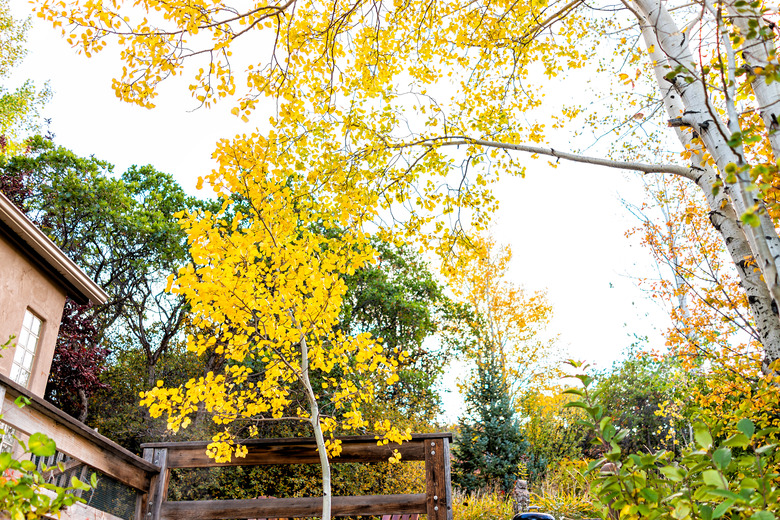How To Kill Poplar Roots
We may receive a commission on purchases made from links.
Poplar trees (Populus spp.), also known as aspens and cottonwoods, share many characteristics, including fast growth, attractive bright yellow fall color, and root suckers that sprout even after the tree has been cut down. In general, poplar roots are not exceptionally invasive, but if there's a leaking sewer or water line nearby, they will find their way to that source of nutrients and moisture. Many poplar species are also large trees with wide root systems that can produce root sprouts or suckers 300 feet or more from the original tree trunk.
About the Poplar Varieties
About the Poplar Varieties
The 35 poplar species, which are loosely divided into three groups (aspens, cottonwoods, and poplars), are all members of the willow family (Salicaceae). Many of the North American poplars found in suburban and urban landscapes are hybrids of the native cottonwood (Populus deltoides) and various poplar species. Native cottonwoods are hardy in U.S. Department of Agriculture plant hardiness zones 2 through 9, but many of the poplar hybrids are less hardy. Among the other parent trees are the black poplar (Populus nigra, USDA zones 2-10); balsam poplar (Populus balsamifera, USDA zones 5-9), which is also known as black cottonwood; and Japanese poplar (Populus maximowiczii, USDA zones 4-7).
Poplar Tree Roots and Other Problems
Poplar Tree Roots and Other Problems
Poplar trees can reach a height of 40 to 100 feet and feature a canopy ranging from 10 to 35 feet wide depending on the species. The roots spread two to three times the height of the tree, reaching up to 300 feet from the tree trunk. Like other members of the willow family, poplars prefer moist soils, and the roots will seek moisture from any source, including nearby water and sewer lines that may be leaking.
Most but not all poplar species produce multiple suckers from their shallow roots, resulting in thickets of multistemmed trees emerging around the original tree. In fact, Pando the Tree (Populus tremuloides, zones 1-7) is the largest organism in the world — a forest of more than 47,000 quaking aspen trunks connected by a single root system.
Other problems with poplar trees include the cottony, seed-filled fruits that litter the neighborhood in early spring. Because the trees are male or female, homeowners and landscapers tend to plant male trees to avoid the cottony mess produced by female trees. However, male trees produce significant amounts of pollen that cause allergic reactions in sensitive individuals.
Solving Poplar Root Problems
Solving Poplar Root Problems
Prevent poplar roots from invading your water and sewer lines by keeping your property in good repair. Avoid planting these large trees close to structures and in lawns, where frequent watering and fertilization will nourish the tree as much as or more than the grass. The shallow roots may also rise above the soil and impede mowing. In some cases, you can cut the tree's roots back, but unless you install a barrier between the tree and the hardscape or pipes, the roots will not only grow back but the tree will produce additional root sprouts.
If removal of the tree becomes necessary, you have to kill the entire root system, or you'll fight root sprouts for two years or longer. Even if the tree removal company grinds up the stump and largest roots, new sprouts are likely to rise from the extensive root system. Put on gloves, safety goggles, and a mask and follow the instructions on the label to ensure optimum results.
- Apply a triclopyr or glyphosate herbicide product within five minutes to the inner bark, called phloem, and cambium layers of the freshly cut tree trunk, which will pull the herbicide down into the root system.
- Remove root sprouts just below ground level and brush or spray an herbicide onto the cut stems. You can cut the bottom out of a coffee can and use it as a protective surround to prevent overspray onto desirable plants.
- Monitor the area for new root sprouts up to 300 feet away from the tree trunk. The sprouts should be removed as quickly as possible, or they will begin to feed the underlying root system, resulting in more sprouts and eventually new trees.
Use caution with herbicides, as they can affect nearby trees, shrubs, and other plants. Avoid using herbicides on the root sprouts from a desirable tree; instead, cut with pruners or mow over the emerging stems so you don't accidentally damage or kill the tree you wanted to keep.
Warning
Keep all cutting tools and herbicides out of the reach of children and pets.
